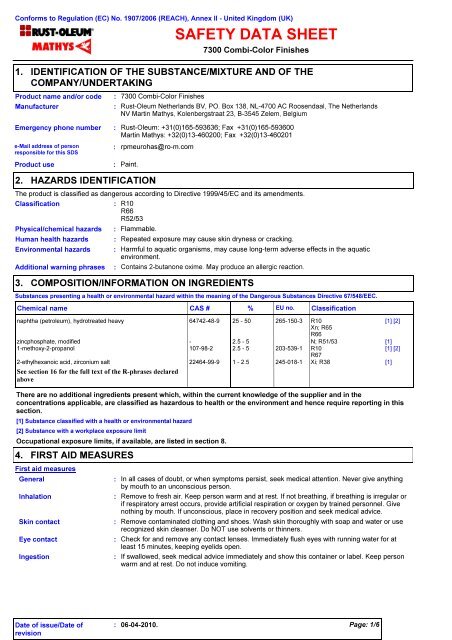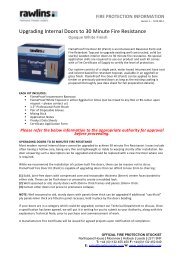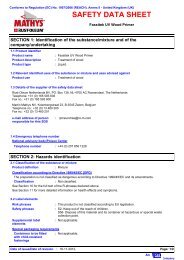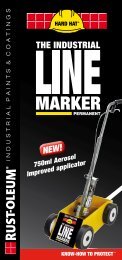SAFETY DATA SHEET - Rawlins Paints
SAFETY DATA SHEET - Rawlins Paints
SAFETY DATA SHEET - Rawlins Paints
Create successful ePaper yourself
Turn your PDF publications into a flip-book with our unique Google optimized e-Paper software.
Conforms to Regulation (EC) No. 1907/2006 (REACH), Annex II - United Kingdom (UK)<br />
1.<br />
<strong>SAFETY</strong> <strong>DATA</strong> <strong>SHEET</strong><br />
7300 Combi-Color Finishes<br />
IDENTIFICATION OF THE SUBSTANCE/MIXTURE AND OF THE<br />
COMPANY/UNDERTAKING<br />
Product name and/or code : 7300 Combi-Color Finishes<br />
Manufacturer : Rust-Oleum Netherlands BV, PO. Box 138, NL-4700 AC Roosendaal, The Netherlands<br />
NV Martin Mathys, Kolenbergstraat 23, B-3545 Zelem, Belgium<br />
Emergency phone number : Rust-Oleum: +31(0)165-593636; Fax +31(0)165-593600<br />
Martin Mathys: +32(0)13-460200; Fax +32(0)13-460201<br />
e-Mail address of person<br />
responsible for this SDS<br />
Product use : Paint.<br />
2.<br />
HAZARDS IDENTIFICATION<br />
:<br />
rpmeurohas@ro-m.com<br />
The product is classified as dangerous according to Directive 1999/45/EC and its amendments.<br />
Classification : R10<br />
R66<br />
R52/53<br />
Physical/chemical hazards : Flammable.<br />
Human health hazards : Repeated exposure may cause skin dryness or cracking.<br />
Environmental hazards : Harmful to aquatic organisms, may cause long-term adverse effects in the aquatic<br />
environment.<br />
Additional warning phrases : Contains 2-butanone oxime. May produce an allergic reaction.<br />
3.<br />
COMPOSITION/INFORMATION ON INGREDIENTS<br />
Substances presenting a health or environmental hazard within the meaning of the Dangerous Substances Directive 67/548/EEC.<br />
Chemical name<br />
CAS # % EU no. Classification<br />
naphtha (petroleum), hydrotreated heavy 64742-48-9 25 - 50 265-150-3 R10<br />
Xn; R65<br />
R66<br />
[1] [2]<br />
zincphosphate, modified - 2.5 - 5 N; R51/53 [1]<br />
1-methoxy-2-propanol 107-98-2 2.5 - 5 203-539-1 R10<br />
[1] [2]<br />
2-ethylhexanoic acid, zirconium salt 22464-99-9 1 - 2.5 245-018-1 Xi; R38 [1]<br />
See section 16 for the full text of the R-phrases declared<br />
above<br />
There are no additional ingredients present which, within the current knowledge of the supplier and in the<br />
concentrations applicable, are classified as hazardous to health or the environment and hence require reporting in this<br />
section.<br />
[1] Substance classified with a health or environmental hazard<br />
[2] Substance with a workplace exposure limit<br />
Occupational exposure limits, if available, are listed in section 8.<br />
4.<br />
FIRST AID MEASURES<br />
First aid measures<br />
General : In all cases of doubt, or when symptoms persist, seek medical attention. Never give anything<br />
by mouth to an unconscious person.<br />
Inhalation<br />
: Remove to fresh air. Keep person warm and at rest. If not breathing, if breathing is irregular or<br />
if respiratory arrest occurs, provide artificial respiration or oxygen by trained personnel. Give<br />
nothing by mouth. If unconscious, place in recovery position and seek medical advice.<br />
Skin contact<br />
: Remove contaminated clothing and shoes. Wash skin thoroughly with soap and water or use<br />
recognized skin cleanser. Do NOT use solvents or thinners.<br />
Eye contact<br />
: Check for and remove any contact lenses. Immediately flush eyes with running water for at<br />
least 15 minutes, keeping eyelids open.<br />
Ingestion<br />
: If swallowed, seek medical advice immediately and show this container or label. Keep person<br />
warm and at rest. Do not induce vomiting.<br />
Date of issue/Date of<br />
revision<br />
: 06-04-2010. Page: 1/6<br />
R67
7300 Combi-Color Finishes<br />
5.<br />
FIRE-FIGHTING MEASURES<br />
Extinguishing media : Recommended: alcohol-resistant foam, CO2, powders, water spray.<br />
Not to be used : water jet.<br />
Recommendations : Fire will produce dense black smoke. Exposure to decomposition products may cause a health<br />
hazard. Appropriate breathing apparatus may be required. Cool closed containers exposed to<br />
fire with water. Do not release runoff from fire to drains or watercourses.<br />
Hazardous combustion<br />
products<br />
6. ACCIDENTAL RELEASE MEASURES<br />
: Decomposition products may include the following materials:<br />
carbon dioxide<br />
carbon monoxide<br />
metal oxide/oxides<br />
Personal precautions : Exclude sources of ignition and ventilate the area. Avoid breathing vapor or mist. Refer to<br />
protective measures listed in sections 7 and 8.<br />
Spill : Contain and collect spillage with non-combustible, absorbent material e.g. sand, earth,<br />
vermiculite or diatomaceous earth and place in container for disposal according to local<br />
regulations (see section 13). Do not allow to enter drains or watercourses. Preferably clean<br />
with a detergent. Avoid using solvents. If the product contaminates lakes, rivers, or sewers,<br />
inform the appropriate authorities in accordance with local regulations.<br />
Note: see section 8 for personal protective equipment and section 13 for waste disposal.<br />
7.<br />
Handling<br />
Storage<br />
HANDLING AND STORAGE<br />
:<br />
:<br />
Vapors are heavier than air and may spread along floors. Vapors may form explosive mixtures<br />
with air. Prevent the creation of flammable or explosive concentrations of vapors in air and<br />
avoid vapor concentrations higher than the occupational exposure limits.<br />
In addition, the product should only be used in areas from which all naked lights and other<br />
sources of ignition have been excluded. Electrical equipment should be protected to the<br />
appropriate standard.<br />
Keep container tightly closed. Keep away from heat, sparks and flame. No sparking tools<br />
should be used.<br />
Avoid contact with skin and eyes. Avoid the inhalation of dust, particulates, spray or mist<br />
arising from the application of this preparation. Avoid inhalation of dust from sanding.<br />
Eating, drinking and smoking should be prohibited in areas where this material is handled,<br />
stored and processed. Workers should wash hands and face before eating, drinking and<br />
smoking.<br />
Put on appropriate personal protective equipment (see section 8).<br />
Comply with the health and safety at work laws.<br />
Store in accordance with local regulations. Observe label precautions. Do not store above the<br />
following temperature: 35°C (95°F). Store in a cool, well-ventilated area away from<br />
incompatible materials and ignition sources.<br />
Keep away from: oxidizing agents, strong alkalis, strong acids.<br />
No smoking. Prevent unauthorized access. Containers that have been opened must be<br />
carefully resealed and kept upright to prevent leakage.<br />
Do not empty into drains.<br />
8. EXPOSURE CONTROLS/PERSONAL PROTECTION<br />
Engineering measures : Provide adequate ventilation. Where reasonably practicable, this should be achieved by the<br />
use of local exhaust ventilation and good general extraction. If these are not sufficient to<br />
maintain concentrations of particulates and solvent vapors below the OEL, suitable respiratory<br />
protection must be worn.<br />
Ingredient name Occupational exposure limits<br />
naphtha (petroleum), hydrotreated heavy EH40/2005 WELs (United Kingdom (UK), 8/2007).<br />
STEL: 850 mg/m³, (as turpentine (150 ppm)) 15 minute(s). Form: Vapor<br />
TWA: 566 mg/m³, (as turpentine (100 ppm)) 8 hour(s). Form: Vapor<br />
1-methoxy-2-propanol EH40/2005 WELs (United Kingdom (UK), 8/2007). Absorbed through skin.<br />
STEL: 560 mg/m³ 15 minute(s).<br />
STEL: 150 ppm 15 minute(s).<br />
TWA: 375 mg/m³ 8 hour(s).<br />
TWA: 100 ppm 8 hour(s).<br />
Exposure controls/personal protection<br />
Date of issue/Date of<br />
revision<br />
: 06-04-2010. Page: 2/6
7300 Combi-Color Finishes<br />
8. EXPOSURE CONTROLS/PERSONAL PROTECTION<br />
Occupational exposure<br />
controls<br />
Hygiene measures<br />
Respiratory protection<br />
Hand protection<br />
Eye protection<br />
Skin protection :<br />
Environmental exposure<br />
controls<br />
9.<br />
: Use only with adequate ventilation. Use process enclosures, local exhaust ventilation or other<br />
engineering controls to keep worker exposure to airborne contaminants below any<br />
recommended or statutory limits. The engineering controls also need to keep gas, vapor or<br />
dust concentrations below any lower explosive limits. Use explosion-proof ventilation<br />
equipment.<br />
: Wash hands, forearms and face thoroughly after handling chemical products, before eating,<br />
smoking and using the lavatory and at the end of the working period. Appropriate techniques<br />
should be used to remove potentially contaminated clothing. Wash contaminated clothing<br />
before reusing. Ensure that eyewash stations and safety showers are close to the workstation<br />
location.<br />
: Use a properly fitted, air-purifying or air-fed respirator complying with an approved standard if a<br />
risk assessment indicates this is necessary. Respirator selection must be based on known or<br />
anticipated exposure levels, the hazards of the product and the safe working limits of the<br />
selected respirator.<br />
Recommended: organic vapor (Type A) and particulate filter (EN 140).<br />
: Chemical-resistant, impervious gloves complying with an approved standard should be worn at<br />
all times when handling chemical products if a risk assessment indicates this is necessary.<br />
>8 hours (breakthrough time): For prolonged or repeated handling, use the following type of<br />
gloves: nitrile rubber or neoprene (EN 374) .<br />
Barrier creams may help to protect the exposed areas of the skin but should not be applied once exposure has occurred.<br />
The user must check that the final choice of type of glove selected for handling this product is the most appropriate and<br />
takes into account the particular conditions of use, as included in the user's risk assessment.<br />
:<br />
:<br />
Safety eyewear complying with an approved standard should be used when a risk assessment<br />
indicates this is necessary to avoid exposure to liquid splashes, mists, gases or dusts.<br />
Recommended: safety glasses with side-shields (EN 166).<br />
Personal protective equipment for the body should be selected based on the task being<br />
performed and the risks involved and should be approved by a specialist before handling this<br />
product.<br />
Recommended: disposable overall .<br />
Emissions from ventilation or work process equipment should be checked to ensure they<br />
comply with the requirements of environmental protection legislation. In some cases, fume<br />
scrubbers, filters or engineering modifications to the process equipment will be necessary to<br />
reduce emissions to acceptable levels.<br />
PHYSICAL AND CHEMICAL PROPERTIES<br />
Physical state<br />
: Liquid.<br />
Odor<br />
: Hydrocarbon. [Slight]<br />
Color<br />
: Depending on productnumber<br />
Flash point : Closed cup: 40°C (104°F) [ISO EN DIN 1523 / DIN 53213-1]<br />
Boiling point : >160°C (>320°F)<br />
Explosion limits : Lower: 0,6%<br />
Upper: 8%<br />
Vapor pressure : 0,7 kPa (5,25 mm Hg)<br />
Vapor density : >1 [Air = 1]<br />
Evaporation rate (BuAc=1) : 0,2 (butyl acetate = 1)<br />
Volatility % : 43 to 50% (v/v), 28 to 50% (w/w)<br />
Viscosity : Dynamic: 1100 to 2250 mPa·s (1100 to 2250 cP)<br />
Relative density (kg/L) : 0,97 to 1,32<br />
10. STABILITY AND REACTIVITY<br />
Stable under recommended storage and handling conditions (see section 7).<br />
Hazardous decomposition products: carbon monoxide, carbon dioxide, smoke, oxides of nitrogen.<br />
Keep away from the following materials to prevent strong exothermic reactions: oxidizing agents, strong alkalis, strong acids.<br />
11. TOXICOLOGICAL INFORMATION<br />
There is no data available on the preparation itself. The preparation has been assessed following the conventional method of the<br />
Dangerous Preparations Directive 1999/45/EC and classified for toxicological hazards accordingly. See sections 3 and 15 for details.<br />
Exposure to component solvent vapor concentrations in excess of the stated occupational exposure limit may result in adverse health<br />
effects such as mucous membrane and respiratory system irritation and adverse effects on the kidneys, liver and central nervous<br />
system. Solvents may cause some of the above effects by absorption through the skin. Symptoms and signs include headache,<br />
dizziness, fatigue, muscular weakness, drowsiness and, in extreme cases, loss of consciousness. Repeated or prolonged contact<br />
with the preparation may cause removal of natural fat from the skin, resulting in non-allergic contact dermatitis and absorption<br />
through the skin. If splashed in the eyes, the liquid may cause irritation and reversible damage.<br />
Contains 2-butanone oxime. May produce an allergic reaction.<br />
Date of issue/Date of<br />
revision<br />
: 06-04-2010. Page: 3/6
7300 Combi-Color Finishes<br />
11. TOXICOLOGICAL INFORMATION<br />
Acute toxicity<br />
Product/ingredient name Result Species Dose Exposure<br />
naphtha (petroleum), hydrotreated heavy LD50 Dermal Rabbit >3000 mg/kg -<br />
LD50 Oral Rat >15000 mg/kg -<br />
LC50 Inhalation<br />
Vapor<br />
Rat >5.5 mg/L 4 hours<br />
zincphosphate, modified LD50 Oral Rat >5000 mg/kg -<br />
1-methoxy-2-propanol LD50 Intraperitoneal Rat 3720 mg/kg -<br />
LD50 Oral Rat 6600 mg/kg -<br />
LD50 Subcutaneous Rat 7800 mg/kg -<br />
LDLo Oral Rat 3739 mg/kg -<br />
LC50 Inhalation<br />
Vapor<br />
Rat 55000 mg/m³ 4 hours<br />
LC50 Inhalation Gas. Rat 10000 ppm 5 hours<br />
LCLo Inhalation<br />
Vapor<br />
Rat 7000 ppm 6 hours<br />
12. ECOLOGICAL INFORMATION<br />
There is no data available on the preparation itself.<br />
Do not allow to enter drains or watercourses.<br />
The preparation has been assessed following the conventional method of the Dangerous Preparations Directive 1999/45/EC and<br />
is classified for eco-toxicological properties accordingly. See sections 2 and 15 for details.<br />
Aquatic ecotoxicity<br />
Ingredient name Result Species<br />
Exposure<br />
naphtha (petroleum), hydrotreated<br />
heavy<br />
Acute EC50 >1000 mg/L Daphnia 4 hours<br />
Acute IC50 >1000 mg/L Algae 4 hours<br />
Acute LC50 >1000 mg/L Fish 4 hours<br />
zincphosphate, modified Acute EC50 10 to 50 mg/L Daphnia - Daphnia Magma 48 hours<br />
Acute EC50 10 to 20 mg/L Algae - Desmodesmus subspicatus 72 hours<br />
Acute LC50 1 to 5 mg/L Fish - Trout - oncorhynchus mykiss 96 hours<br />
1-methoxy-2-propanol Acute EC50 >1000 mg/l Algae - Selenastrum capricomutum 7 days<br />
Acute LC50 23300 mg/l Daphnia 96 hours<br />
Ecological information<br />
Biodegradability<br />
Acute LC50 20800 mg/l Fish - Fathead minnow 96 hours<br />
Ingredient name Test Result Dose<br />
Inoculum<br />
1-methoxy-2-propanol OECD 301E 96 % - Readily - 28 days - -<br />
- >90 % - Readily - 5 days 1.95 gO2/g ThOD -<br />
OECD 301C 88 to 92 % - Readily - 28 days - -<br />
Conclusion/Remark : Not available.<br />
Ingredient name Aquatic half-life Photolysis Biodegradability<br />
naphtha (petroleum), hydrotreated heavy Fresh water
7300 Combi-Color Finishes<br />
14. TRANSPORT INFORMATION<br />
Regulatory<br />
information<br />
ADR/RID Class -<br />
- - -<br />
IMDG Class 1263 Paint. 3 III<br />
IATA Class<br />
UN number Proper shipping name Classes PG* Label<br />
1263<br />
Paint.<br />
PG* : Packing group<br />
The "viscosity exemption" provisions do not apply to air transport.<br />
15. REGULATORY INFORMATION<br />
EU regulations<br />
Risk phrases<br />
3<br />
III<br />
Additional information<br />
Remarks<br />
Transport acc. ADR 2.2.3.1.5 [SP223]<br />
Emergency schedules (EmS):<br />
F-E + S-E<br />
Marine pollutant:<br />
NO<br />
Remarks:<br />
(< 30L: ) Transport acc. IMDG<br />
2.3.2.5 [SP223]<br />
Passenger and Cargo Aircraft<br />
Quantity limitation: 60 L<br />
Packaging instructions: 309<br />
Cargo Aircraft OnlyQuantity<br />
limitation: 220 L<br />
Packaging instructions: 310<br />
Limited Quantities - Passenger<br />
AircraftQuantity limitation: 10 L<br />
Packaging instructions: Y309<br />
: The product is classified and labelled for supply in accordance with the Directive 1999/45/EC<br />
as follows:<br />
: R10- Flammable.<br />
R66- Repeated exposure may cause skin dryness or cracking.<br />
R52/53- Harmful to aquatic organisms, may cause long-term adverse effects in the aquatic<br />
environment.<br />
Safety phrases : S2- Keep out of the reach of children.<br />
S23- Do not breathe vapor or spray.<br />
S24- Avoid contact with skin.<br />
S46- If swallowed, seek medical advice immediately and show this container or label.<br />
S51- Use only in well-ventilated areas.<br />
S56- Dispose of this material and its container at hazardous or special waste collection point.<br />
VOC for Ready-for-Use<br />
Mixture<br />
Europe inventory : Not determined.<br />
Other EU regulations<br />
Additional warning phrases : Contains 2-butanone oxime. May produce an allergic reaction.<br />
CN code : 3208 10 90<br />
16. OTHER INFORMATION<br />
Full text of R-phrases<br />
referred to in sections 2 and<br />
3 - United Kingdom (UK)<br />
Notice to reader<br />
: IIA/i. One-pack performance coatings. EU limit values: 600g/l (2007) 500g/l (2010.)<br />
This product contains a maximum of 477 g/l VOC.<br />
:<br />
R10- Flammable.<br />
R65- Harmful: may cause lung damage if swallowed.<br />
R38- Irritating to skin.<br />
R66- Repeated exposure may cause skin dryness or cracking.<br />
R67- Vapors may cause drowsiness and dizziness.<br />
R51/53- Toxic to aquatic organisms, may cause long-term adverse effects in the aquatic<br />
environment.<br />
R52/53- Harmful to aquatic organisms, may cause long-term adverse effects in the aquatic<br />
environment.<br />
The information in this Safety Data Sheet is required pursuant to EU Directive 91/155/EEC and its amendments.<br />
Indicates information that has changed from previously issued version.<br />
The information in this SDS is based on the present state of our knowledge and on current laws. The product is not to be used<br />
for purposes other than those specified under section 1 without first obtaining written handling instructions. It is always the<br />
responsibility of the user to take all necessary steps to fulfill the demands set out in the local rules and legislation. The<br />
information in this SDS is meant to be a description of the safety requirements for our product. It is not to be considered a<br />
guarantee of the product's properties. ©Copyright by Rust-Oleum Netherlands B.V. / Martin Mathys B.V.<br />
An<br />
Date of issue/Date of<br />
revision<br />
Company<br />
Version 0.12<br />
Date of issue 06-04-2010.<br />
v.4.0.<br />
: 06-04-2010. Page: 5/6<br />
Page: 5/6<br />
Printed 06-04-2010.
7300 Combi-Color Finishes<br />
16. OTHER INFORMATION<br />
Date of issue/Date of<br />
revision<br />
: 06-04-2010. Page: 6/6






